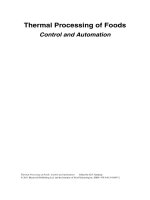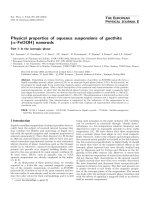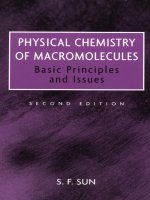Physical chemistry of foods dekker
Bạn đang xem bản rút gọn của tài liệu. Xem và tải ngay bản đầy đủ của tài liệu tại đây (11.77 MB, 807 trang )
Physical Chemistry
of Foods
Pieter Walstra
Wageningen University
Wageningen, The Netherlands
Marcel Dekker, Inc.
TM
Copyright 2003 by Marcel Dekker, Inc. All Rights Reserved.
New York • Basel
ISBN: 0-8247-9355-2
This book is printed on acid-free paper.
Headquarters
Marcel Dekker, Inc.
270 Madison Avenue, New York, NY 10016
tel: 212-696-9000; fax: 212-685-4540
Eastern Hemisphere Distribution
Marcel Dekker AG
Hutgasse 4, Postfach 812, CH-4001 Basel, Switzerland
tel: 41-61-260-6300; fax: 41-61-260-6333
World Wide Web
The publisher offers discounts on this book when ordered in bulk quantities. For more
information, write to Special Sales/Professional Marketing at the headquarters address
above.
Copyright # 2003 by Marcel Dekker, Inc. All Rights Reserved.
Neither this book nor any part may be reproduced or transmitted in any form or by any
means, electronic or mechanical, including photocopying, microfilming, and recording, or
by any information storage and retrieval system, without permission in writing from the
publisher.
Current printing (last digit):
10 9 8 7 6 5 4 3 2 1
PRINTED IN THE UNITED STATES OF AMERICA
Copyright 2003 by Marcel Dekker, Inc. All Rights Reserved.
FOOD SCIENCE AND TECHNOLOGY
A Series of Monographs, Textbooks, and Reference Books
EDITORIAL BOARD
Senior Editors
Owen R. Fennema University of Wisconsin–Madison
Y.H. Hui Science Technology System
Marcus Karel Rutgers University (emeritus)
Pieter Walstra Wageningen University
John R. Whitaker University of California–Davis
Additives P. Michael Davidson University of Tennessee–Knoxville
Dairy science James L. Steele University of Wisconsin–Madison
Flavor chemistry and sensory analysis John H. Thorngate III University
of California–Davis
Food engineering Daryl B. Lund University of Wisconsin–Madison
Food proteins/food chemistry
Rickey Y. Yada
University of Guelph
Health and disease Seppo Salminen University of Turku, Finland
Nutrition and nutraceuticals Mark Dreher Mead Johnson Nutritionals
Phase transition/food microstructure Richard W. Hartel University of
Wisconsin–Madison
Processing and preservation Gustavo V. Barbosa-Cánovas Washington
State University–Pullman
Safety and toxicology Sanford Miller University of Texas–Austin
1. Flavor Research: Principles and Techniques, R. Teranishi, I. Hornstein, P. Issenberg, and E. L. Wick
2. Principles of Enzymology for the Food Sciences, John R. Whitaker
3. Low-Temperature Preservation of Foods and Living Matter, Owen R.
Fennema, William D. Powrie, and Elmer H. Marth
4. Principles of Food Science
Part I: Food Chemistry, edited by Owen R. Fennema
Part II: Physical Methods of Food Preservation, Marcus Karel, Owen
R. Fennema, and Daryl B. Lund
5. Food Emulsions, edited by Stig E. Friberg
6. Nutritional and Safety Aspects of Food Processing, edited by Steven
R. Tannenbaum
7. Flavor Research: Recent Advances, edited by R. Teranishi, Robert A.
Flath, and Hiroshi Sugisawa
8. Computer-Aided Techniques in Food Technology, edited by Israel
Saguy
Copyright 2003 by Marcel Dekker, Inc. All Rights Reserved.
9. Handbook of Tropical Foods, edited by Harvey T. Chan
10. Antimicrobials in Foods, edited by Alfred Larry Branen and P. Michael
Davidson
11. Food Constituents and Food Residues: Their Chromatographic
Determination, edited by James F. Lawrence
12. Aspartame: Physiology and Biochemistry, edited by Lewis D. Stegink
and L. J. Filer, Jr.
13. Handbook of Vitamins: Nutritional, Biochemical, and Clinical Aspects,
edited by Lawrence J. Machlin
14. Starch Conversion Technology, edited by G. M. A. van Beynum and J.
A. Roels
15. Food Chemistry: Second Edition, Revised and Expanded, edited by
Owen R. Fennema
16. Sensory Evaluation of Food: Statistical Methods and Procedures, Michael O'Mahony
17. Alternative Sweeteners, edited by Lyn O'Brien Nabors and Robert C.
Gelardi
18. Citrus Fruits and Their Products: Analysis and Technology, S. V. Ting
and Russell L. Rouseff
19. Engineering Properties of Foods, edited by M. A. Rao and S. S. H.
Rizvi
20. Umami: A Basic Taste, edited by Yojiro Kawamura and Morley R.
Kare
21. Food Biotechnology, edited by Dietrich Knorr
22. Food Texture: Instrumental and Sensory Measurement, edited by
Howard R. Moskowitz
23. Seafoods and Fish Oils in Human Health and Disease, John E.
Kinsella
24. Postharvest Physiology of Vegetables, edited by J. Weichmann
25. Handbook of Dietary Fiber: An Applied Approach, Mark L. Dreher
26. Food Toxicology, Parts A and B, Jose M. Concon
27. Modern Carbohydrate Chemistry, Roger W. Binkley
28. Trace Minerals in Foods, edited by Kenneth T. Smith
29. Protein Quality and the Effects of Processing, edited by R. Dixon
Phillips and John W. Finley
30. Adulteration of Fruit Juice Beverages, edited by Steven Nagy, John A.
Attaway, and Martha E. Rhodes
31. Foodborne Bacterial Pathogens, edited by Michael P. Doyle
32. Legumes: Chemistry, Technology, and Human Nutrition, edited by
Ruth H. Matthews
33. Industrialization of Indigenous Fermented Foods, edited by Keith H.
Steinkraus
34. International Food Regulation Handbook: Policy · Science · Law,
edited by Roger D. Middlekauff and Philippe Shubik
35. Food Additives, edited by A. Larry Branen, P. Michael Davidson, and
Seppo Salminen
36. Safety of Irradiated Foods, J. F. Diehl
Copyright 2003 by Marcel Dekker, Inc. All Rights Reserved.
37. Omega-3 Fatty Acids in Health and Disease, edited by Robert S. Lees
and Marcus Karel
38. Food Emulsions: Second Edition, Revised and Expanded, edited by
Kåre Larsson and Stig E. Friberg
39. Seafood: Effects of Technology on Nutrition, George M. Pigott and
Barbee W. Tucker
40. Handbook of Vitamins: Second Edition, Revised and Expanded,
edited by Lawrence J. Machlin
41. Handbook of Cereal Science and Technology, Klaus J. Lorenz and
Karel Kulp
42. Food Processing Operations and Scale-Up, Kenneth J. Valentas,
Leon Levine, and J. Peter Clark
43. Fish Quality Control by Computer Vision, edited by L. F. Pau and R.
Olafsson
44. Volatile Compounds in Foods and Beverages, edited by Henk Maarse
45. Instrumental Methods for Quality Assurance in Foods, edited by
Daniel Y. C. Fung and Richard F. Matthews
46. Listeria, Listeriosis, and Food Safety, Elliot T. Ryser and Elmer H.
Marth
47. Acesulfame-K, edited by D. G. Mayer and F. H. Kemper
48. Alternative Sweeteners: Second Edition, Revised and Expanded, edited by Lyn O'Brien Nabors and Robert C. Gelardi
49. Food Extrusion Science and Technology, edited by Jozef L. Kokini,
Chi-Tang Ho, and Mukund V. Karwe
50. Surimi Technology, edited by Tyre C. Lanier and Chong M. Lee
51. Handbook of Food Engineering, edited by Dennis R. Heldman and
Daryl B. Lund
52. Food Analysis by HPLC, edited by Leo M. L. Nollet
53. Fatty Acids in Foods and Their Health Implications, edited by Ching
Kuang Chow
54. Clostridium botulinum: Ecology and Control in Foods, edited by
Andreas H. W. Hauschild and Karen L. Dodds
55. Cereals in Breadmaking: A Molecular Colloidal Approach,
Ann-Charlotte Eliasson and Kåre Larsson
56. Low-Calorie Foods Handbook, edited by Aaron M. Altschul
57. Antimicrobials in Foods: Second Edition, Revised and Expanded,
edited by P. Michael Davidson and Alfred Larry Branen
58. Lactic Acid Bacteria, edited by Seppo Salminen and Atte von Wright
59. Rice Science and Technology, edited by Wayne E. Marshall and
James I. Wadsworth
60. Food Biosensor Analysis, edited by Gabriele Wagner and George G.
Guilbault
61. Principles of Enzymology for the Food Sciences: Second Edition, John
R. Whitaker
62. Carbohydrate Polyesters as Fat Substitutes, edited by Casimir C.
Akoh and Barry G. Swanson
63. Engineering Properties of Foods: Second Edition, Revised and
Expanded, edited by M. A. Rao and S. S. H. Rizvi
Copyright 2003 by Marcel Dekker, Inc. All Rights Reserved.
64. Handbook of Brewing, edited by William A. Hardwick
65. Analyzing Food for Nutrition Labeling and Hazardous Contaminants,
edited by Ike J. Jeon and William G. Ikins
66. Ingredient Interactions: Effects on Food Quality, edited by Anilkumar
G. Gaonkar
67. Food Polysaccharides and Their Applications, edited by Alistair M.
Stephen
68. Safety of Irradiated Foods: Second Edition, Revised and Expanded, J.
F. Diehl
69. Nutrition Labeling Handbook, edited by Ralph Shapiro
70. Handbook of Fruit Science and Technology: Production, Composition,
Storage, and Processing, edited by D. K. Salunkhe and S. S. Kadam
71. Food Antioxidants: Technological, Toxicological, and Health Perspectives, edited by D. L. Madhavi, S. S. Deshpande, and D. K. Salunkhe
72. Freezing Effects on Food Quality, edited by Lester E. Jeremiah
73. Handbook of Indigenous Fermented Foods: Second Edition, Revised
and Expanded, edited by Keith H. Steinkraus
74. Carbohydrates in Food, edited by Ann-Charlotte Eliasson
75. Baked Goods Freshness: Technology, Evaluation, and Inhibition of
Staling, edited by Ronald E. Hebeda and Henry F. Zobel
76. Food Chemistry: Third Edition, edited by Owen R. Fennema
77. Handbook of Food Analysis: Volumes 1 and 2, edited by Leo M. L.
Nollet
78. Computerized Control Systems in the Food Industry, edited by Gauri
S. Mittal
79. Techniques for Analyzing Food Aroma, edited by Ray Marsili
80. Food Proteins and Their Applications, edited by Srinivasan Damodaran and Alain Paraf
81. Food Emulsions: Third Edition, Revised and Expanded, edited by Stig
E. Friberg and Kåre Larsson
82. Nonthermal Preservation of Foods, Gustavo V. Barbosa-Cánovas,
Usha R. Pothakamury, Enrique Palou, and Barry G. Swanson
83. Milk and Dairy Product Technology, Edgar Spreer
84. Applied Dairy Microbiology, edited by Elmer H. Marth and James L.
Steele
85. Lactic Acid Bacteria: Microbiology and Functional Aspects: Second
Edition, Revised and Expanded, edited by Seppo Salminen and Atte
von Wright
86. Handbook of Vegetable Science and Technology: Production,
Composition, Storage, and Processing, edited by D. K. Salunkhe and
S. S. Kadam
87. Polysaccharide Association Structures in Food, edited by Reginald H.
Walter
88. Food Lipids: Chemistry, Nutrition, and Biotechnology, edited by
Casimir C. Akoh and David B. Min
89. Spice Science and Technology, Kenji Hirasa and Mitsuo Takemasa
Copyright 2003 by Marcel Dekker, Inc. All Rights Reserved.
90. Dairy Technology: Principles of Milk Properties and Processes, P.
Walstra, T. J. Geurts, A. Noomen, A. Jellema, and M. A. J. S. van
Boekel
91. Coloring of Food, Drugs, and Cosmetics, Gisbert Otterstätter
92. Listeria, Listeriosis, and Food Safety: Second Edition, Revised and
Expanded, edited by Elliot T. Ryser and Elmer H. Marth
93. Complex Carbohydrates in Foods, edited by Susan Sungsoo Cho,
Leon Prosky, and Mark Dreher
94. Handbook of Food Preservation, edited by M. Shafiur Rahman
95. International Food Safety Handbook: Science, International Regulation, and Control, edited by Kees van der Heijden, Maged Younes,
Lawrence Fishbein, and Sanford Miller
96. Fatty Acids in Foods and Their Health Implications: Second Edition,
Revised and Expanded, edited by Ching Kuang Chow
97. Seafood Enzymes: Utilization and Influence on Postharvest Seafood
Quality, edited by Norman F. Haard and Benjamin K. Simpson
98. Safe Handling of Foods, edited by Jeffrey M. Farber and Ewen C. D.
Todd
99. Handbook of Cereal Science and Technology: Second Edition, Revised and Expanded, edited by Karel Kulp and Joseph G. Ponte, Jr.
100. Food Analysis by HPLC: Second Edition, Revised and Expanded,
edited by Leo M. L. Nollet
101. Surimi and Surimi Seafood, edited by Jae W. Park
102. Drug Residues in Foods: Pharmacology, Food Safety, and Analysis,
Nickos A. Botsoglou and Dimitrios J. Fletouris
103. Seafood and Freshwater Toxins: Pharmacology, Physiology, and
Detection, edited by Luis M. Botana
104. Handbook of Nutrition and Diet, Babasaheb B. Desai
105. Nondestructive Food Evaluation: Techniques to Analyze Properties
and Quality, edited by Sundaram Gunasekaran
106. Green Tea: Health Benefits and Applications, Yukihiko Hara
107. Food Processing Operations Modeling: Design and Analysis, edited
by Joseph Irudayaraj
108. Wine Microbiology: Science and Technology, Claudio Delfini and
Joseph V. Formica
109. Handbook of Microwave Technology for Food Applications, edited by
Ashim K. Datta and Ramaswamy C. Anantheswaran
110. Applied Dairy Microbiology: Second Edition, Revised and Expanded,
edited by Elmer H. Marth and James L. Steele
111. Transport Properties of Foods, George D. Saravacos and Zacharias
B. Maroulis
112. Alternative Sweeteners: Third Edition, Revised and Expanded, edited
by Lyn O’Brien Nabors
113. Handbook of Dietary Fiber, edited by Susan Sungsoo Cho and Mark
L. Dreher
114. Control of Foodborne Microorganisms, edited by Vijay K. Juneja and
John N. Sofos
115. Flavor, Fragrance, and Odor Analysis, edited by Ray Marsili
Copyright 2003 by Marcel Dekker, Inc. All Rights Reserved.
116. Food Additives: Second Edition, Revised and Expanded, edited by A.
Larry Branen, P. Michael Davidson, Seppo Salminen, and John H.
Thorngate, III
117. Food Lipids: Chemistry, Nutrition, and Biotechnology: Second Edition,
Revised and Expanded, edited by Casimir C. Akoh and David B. Min
118. Food Protein Analysis: Quantitative Effects on Processing, R. K.
Owusu-Apenten
119. Handbook of Food Toxicology, S. S. Deshpande
120. Food Plant Sanitation, edited by Y. H. Hui, Bernard L. Bruinsma, J.
Richard Gorham, Wai-Kit Nip, Phillip S. Tong, and Phil Ventresca
121. Physical Chemistry of Foods, Pieter Walstra
122. Handbook of Food Enzymology, edited by John R. Whitaker, Alphons
G. J. Voragen, and Dominic W. S. Wong
123. Postharvest Physiology and Pathology of Vegetables: Second Edition,
Revised and Expanded, edited by Jerry A. Bartz and Jeffrey K. Brecht
124. Characterization of Cereals and Flours: Properties, Analysis, and Applications, edited by Gönül Kaletunç and Kenneth J. Breslauer
125. International Handbook of Foodborne Pathogens, edited by Marianne
D. Miliotis and Jeffrey W. Bier
Additional Volumes in Preparation
Handbook of Dough Fermentations, edited by Karel Kulp and Klaus
Lorenz
Extraction Optimization in Food Engineering, edited by Constantina
Tzia and George Liadakis
Physical Principles of Food Preservation: Second Edition, Revised
and Expanded, Marcus Karel and Daryl B. Lund
Handbook of Vegetable Preservation and Processing, edited by Y. H.
Hui, Sue Ghazala, Dee M. Graham, K. D. Murrell, and Wai-Kit Nip
Food Process Design, Zacharias B. Maroulis and George D.
Saravacos
Copyright 2003 by Marcel Dekker, Inc. All Rights Reserved.
Foreword
Knowledge of physical chemistry is of great importance to anyone who is
interested in understanding the properties of food, improving its quality and
storage stability, and controlling its behavior during handling. Yet, curricula
in food science often do not contain a course in food physical chemistry,
especially at the undergraduate level, and failure to acquire skills in this
important area can hinder a food scientist’s success in scientific endeavors.
Some believe that an introductory course in physical chemistry offered by a
department of chemistry will fill this void, but I disagree. If possible, an
introductory course in physical chemistry should be a prerequisite for a
course in food physical chemistry—the former providing a sound background in the principles of physical chemistry and the latter focusing on
application of the principles most relevant to food.
Failure of many food science departments to offer a course on food
physical chemistry is attributable mainly to the lack of an appropriate
textbook. Whereas instructors in food science can select from several good
textbooks on food microbiology, food engineering, food chemistry, and
other more specialized topics, choices in food physical chemistry are severely
limited. The publication of Pieter Walstra’s excellent textbook on food
physical chemistry is therefore an event of major importance to the field of
food science. This book will stimulate universities that do not offer this
Copyright 2003 by Marcel Dekker, Inc. All Rights Reserved.
subject to do so, and will improve the quality of instruction in universities
that do. It will also be of great value to food researchers.
Professor Walstra is eminently qualified to write a book on food
physical chemistry because of his in-depth knowledge of the subject and his
understanding of, expertise in, and dedication to food science education.
This book provides comprehensive coverage of food physical chemistry at a
depth suitable for students in food science, and will serve as an excellent
reference source for food researchers. I congratulate Professor Walstra for
this fine accomplishment.
Owen Fennema
Professor
Department of Food Science
University of Wisconsin–Madison
Madison, Wisconsin
Copyright 2003 by Marcel Dekker, Inc. All Rights Reserved.
Preface
The scientific basis needed to understand and predict food properties and
changes occurring in foods during processing, storage and use has been
enormously expanded over the past half-century. This has caused a
revolutionary change in the teaching of food science and technology,
especially by application of the disciplines of organic chemistry, biochemistry, and microbiology. With the possible exception of rheology, application of the more physical disciplines has lagged behind. Many years’
experience in food research and teaching has convinced me—although I am
not a physical chemist—of the importance of physical chemistry and related
theories for food science and technology. Moreover, great progress has been
made during the past two decades in the study of physicochemical
phenomena in foods; yet these aspects often remain greatly underexposed.
The main reason for this deficiency is, in my opinion, that the teaching
of physical chemistry for food science majors is often inadequate. In most
universities, students have one introductory course in basic physical
chemistry; this is unsatisfactory for the following reasons:
1. Many of the subjects are of little or no importance for foods or are
treated in too much theoretical detail (e.g., quantum mechanics,
statistical thermodynamics, much of spectroscopy).
Copyright 2003 by Marcel Dekker, Inc. All Rights Reserved.
2. Many subjects of great importance to foods are not included. In
order to keep the theory simple, the treatment is often restricted to
gases and crystals and dilute, homogeneous, ideal solutions,
whereas most foods are concentrated, inhomogeneous, highly
nonideal systems. In particular, coverage of colloid and surface
science is insufficient.
3. In most cases, the course is taken at the wrong time, that is, before
the student is able to see the relevance of the various subjects for
foods.
The primary aim of this book is to help in remedying this situation. It
can be used as the basis of a course for food science majors at a not-tooearly stage in the curriculum (some universities may prefer a graduate
course). Hence it is written as a textbook. A second aim is its use as a
reference book, since basic aspects of physical chemistry are not always
taken into account in food research or process development. Therefore, I
have tried to cover all subjects of importance that are not treated in most
courses in food chemistry or food processing/engineering.
The selection of topics—including theories, phenomena, systems, and
examples—is naturally colored by my experience and opinions. This means
that the treatment is to some extent biased. In my view this is unavoidable,
but I would like to hear from readers who feel that a topic has been omitted
or overemphasized. Remarks about errors and unclear explanations are also
welcome.
ACKNOWLEDGMENTS
The idea for this book was born when I was asked to give a course on the
physical chemistry of foods in the Department of Food Science at the
University of Guelph, Ontario, Canada, in 1993. This course was based
largely on courses in food physics given at Wageningen University,
developed in cooperation with my colleagues Dr. Ton van Vliet and Dr.
Albert Prins. I also want to mention that Dr. Owen Fennema of the
University of Wisconsin has greatly encouraged me in writing this text.
Several colleagues have made valuable suggestions, which have greatly
improved the quality of this book. I am especially indebted to Dr. Eric
Dickinson, Professor of Food Colloids at the University of Leeds, England,
with whom I discussed plans and who has read and commented on virtually
all my drafts. His contributions have been invaluable. Furthermore, several
colleagues have scrutinized one or more draft chapters: Dr. C. van den Berg,
Dr. B. H. Bijsterbosch, Dr. M. A. J. S. van Boekel, Dr. O. R. Fennema,
Dr. G. J. Fleer, Dr. G. Frens, Dr. H. D. Goff, Dr. H. H. J. de Jongh,
Copyright 2003 by Marcel Dekker, Inc. All Rights Reserved.
Dr. J. Lucassen, Dr. E. H. Lucassen-Reynders, Dr. J. Lyklema, Dr. E. R.
Morris, Dr. W. Norde, Dr. J. H. J. van Opheusden, Dr. L. van der Plas,
Dr. M. J. W. Povey, Dr. J. Verhagen, and Dr. T. van Vliet. I express my
gratitude to all these friends and colleagues.
Pieter Walstra
Copyright 2003 by Marcel Dekker, Inc. All Rights Reserved.
Contents
Foreword
Preface
1 INTRODUCTION
1.1 Physical Chemistry in Food Science and Technology
1.2 About this Book
Bibliography
2 ASPECTS OF THERMODYNAMICS
2.1 Concepts
2.2 Solutions
2.3 Electrolyte Solutions
2.4 Recapitulation
Bibliography
3 BONDS AND INTERACTION FORCES
3.1 Types of Bonds
3.2 Solvation
3.3 Recapitulation
Bibliography
Copyright 2003 by Marcel Dekker, Inc. All Rights Reserved.
4 REACTION KINETICS
4.1 Reaction Order
4.2 Chemical Equilibrium
4.3 Rate Theories
4.4 Further Complications
4.5 Recapitulation
Bibliography
5 TRANSPORT PHENOMENA
5.1 Flow and Viscosity
5.2 Diffusion
5.3 Transport in Composite Materials
5.4 Recapitulation
Bibliography
6 POLYMERS
6.1 Introduction
6.2 Very Dilute Solutions
6.3 Polyelectrolytes
6.4 More Concentrated Solutions
6.5 Phase Separation
6.6 Starch
6.7 Recapitulation
Bibliography
7 PROTEINS
7.1 Description
7.2 Conformational Stability and Denaturation
7.3 Solubility
7.4 Recapitulation
Bibliography
8 WATER RELATIONS
8.1 Water Activity
8.2 Sorption Isotherms
8.3 ‘‘Water Binding’’
8.4 Reaction Rates and Water Content
8.5 Recapitulation
Bibliography
9 DISPERSED SYSTEMS
9.1 Structure
Copyright 2003 by Marcel Dekker, Inc. All Rights Reserved.
9.2
9.3
9.4
Importance of Scale
Particle Size Distributions
Recapitulation
Bibliography
10 SURFACE PHENOMENA
10.1 Surface Tension
10.2 Adsorption
10.3 Surfactants
10.4 Time Effects
10.5 Curved Interfaces
10.6 Contact Angles and Wetting
10.7 Interfacial Tension Gradients
10.8 Interfacial Rheology
10.9 Recapitulation
Bibliography
11 FORMATION OF EMULSIONS AND FOAMS
11.1 Introduction
11.2 Foam Formation and Properties
11.3 Breakup of Drops and Bubbles
11.4 Role of Surfactant
11.5 Recapitulation
Bibliography
12 COLLOIDAL INTERACTIONS
12.1 General Introduction
12.2 DLVO Theory
12.3 Role of Polymers
12.4 Other Interactions
12.5 Recapitulation
Bibliography
13 CHANGES IN DISPERSITY
13.1 Overview
13.2 Aggregation
13.3 Sedimentation
13.4 Coalescence
13.5 Partial Coalescence
13.6 Ostwald Ripening
13.7 Recapitulation
Bibliography
Copyright 2003 by Marcel Dekker, Inc. All Rights Reserved.
14 NUCLEATION
14.1 Phase Transitions
14.2 Nucleation Theory
14.3 Nucleation in a Finely Dispersed Material
14.4 Formation of a Gas Phase
14.5 Recapitulation
Bibliography
15 CRYSTALLIZATION
15.1 The Crystalline State
15.2 Crystal Growth
15.3 Crystallization from Aqueous Solutions
15.4 Fat Crystallization
15.5 Recapitulation
Bibliography
16 GLASS TRANSITIONS AND FREEZING
16.1 The Glassy State
16.2 The Special Glass Transition
16.3 Freezing of Foods
16.4 Recapitulation
Bibliography
17 SOFT SOLIDS
17.1 Rheology and Fracture
17.2 Gels
17.3 Plastic Fats
17.4 Closely Packed Systems
17.5 Cellular Systems
17.6 Recapitulation
Bibliography
APPENDIX A: Frequently Used Symbols for Physical
Quantities
APPENDIX B: Some Frequently Used Abbreviations
APPENDIX C: Some Mathematical Symbols
APPENDIX D: SI Rules for Notation
APPENDIX E: The SI Units System
APPENDIX F: Some Conversion Factors
APPENDIX G: Recalculation of Concentrations
APPENDIX H: Physical Properties of Water at 0–1008C
Copyright 2003 by Marcel Dekker, Inc. All Rights Reserved.
APPENDIX I: Thermodynamic and Physical Properties of
Water and Ice
APPENDIX J: Some Values of the Error Function
Copyright 2003 by Marcel Dekker, Inc. All Rights Reserved.
Appendix A
Frequently Used Symbols for
Physical Quantities
Between parentheses the units—generally SI units—for the quantity are
given, unless the dimensions can vary; (–) means dimensionless.
Unfortunately, the number of physical quantities used is far greater
than the number of symbols available. Many symbols are used with
subscripts and/or superscripts, to identify the quantity further.
Latin
A
a
aw
B
b
bch
C
c
c*
csat
area
Hamaker constant
specific surface area
particle radius
thermodynamic activity
water activity
permeability
second virial coefficient
length of statistical chain element
distance between charged groups along chain
constant
concentration
chain overlap concentration
solubility
Copyright 2003 by Marcel Dekker, Inc. All Rights Reserved.
(m2)
(J)
(mÀ1)
(m)
(–)
(m2)
(mol ? m3 ? kgÀ2 )
(m)
(m)
cp
cn
D
d
E
ES
Ea
e
F
f
G
G0
G00
g
H
h
hP
I
i
J
K
k
kB
L
l
M
m
N
NAV
n
n0
p
pL
specific heat at constant pressure
relative standard deviation of order n
diffusion coefficient
fractal dimensionality
relative deformation
diameter
modulus (in elongation or unspecified)
surface modulus
activation energy for a chemical reaction
electronic charge
force
frequency factor
Gibbs (free) energy
shear modulus
storage (shear) modulus
loss (shear) modulus
acceleration due to gravity
enthalpy
height
distance from a surface; interparticle distance
Planck’s constant
ionic strength
as subscript: indicates class number
aggregation rate; particle flux
nucleation rate
constant
stability constant; equilibrium constant
reaction rate constant
Boltzmann constant
length
eddy size
molar mass
mass
molar concentration
number concentration
number per unit cross-sectional area
Avogadro’s number
degree of polymerization
number of moles
reaction order
refractive index
number of statistical chain elements in a
polymer chain
pressure
Laplace pressure
Copyright 2003 by Marcel Dekker, Inc. All Rights Reserved.
(J ? kgÀ1 ? KÀ1 )
(–)
(m2 ? sÀ1 )
(–)
(–)
(m)
(Pa)
(N ? mÀ1 )
(J ? molÀ1 )
(1:602 ? 10À19 C)
(N)
(Pa)
(Pa)
(Pa)
(9:807 m2 ? sÀ1 )
(m)
(m)
(6:626 ? 10À34 J ? s)
(molar)
(–)
(mÀ3 ? sÀ1 )
(1:381 ? 10À23 J ? KÀ1 )
(m)
(m)
(kg ? kmolÀ1 )
(kg)
(kmol ? mÀ3 )
(mÀ3)
(mÀ2)
(6:022 ? 1023 molÀ1 )
(–)
(–)
(–)
(Pa)
(Pa)
pv
Q
q
R
r
rg
rm
S
Sn
s
T
Tg
t
t0.5
U
u
V
v
W
w
w0
x
x,y,z
z
vapor pressure
volume flow rate
amount of heat
gas constant
radius; radius of curvature; radial coordinate
radius; radial coordinate
radius of gyration
root-mean-square end-to-end distance of
polymer chain
entropy
n-th moment of a (size) distribution
solubility
absolute temperature
glass transition temperature
time
time needed to halve the value of a parameter
internal energy
eddy velocity
volume
colloidal interaction free energy
droplet volume
linear velocity
molar volume
retardation factor in aggregation, etc.
(specific) work
mass fraction of water
kg water per kg dry matter
mole fraction
linear coordinates
valence; net number of charges
(Pa)
(m3 ? sÀ1 )
(J)
(8:315 J ? KÀ1 ? molÀ1 )
(m)
(m)
(m)
(m)
angle
capture efficiency (in aggregation)
degree of ionization
excluded volume parameter
supersaturation ratio
surface excess (surface load)
activity coefficient
interfacial or surface tension
shear strain
free ion activity coefficient
root-mean-square displacement in diffusion
film or layer thickness
phase angle (tan d ¼ G00 / G0 )
(rad)
(–)
(–)
(–)
(–)
(mol ? mÀ2 ; kg ? mÀ2 )
(–)
(N ? mÀ1 )
(–)
(–)
(m)
(m)
(rad)
(mol ? mÀ3 )
(K)
(K)
(s)
(s)
(m ? sÀ1 )
(m3)
(J; J ? mÀ2 )
(m3)
(m ? sÀ1 )
3
(m ? molÀ1 )
(–)
(–)
(–)
(–)
(m)
Greek
a
b
G
g
g+
D
d
Copyright 2003 by Marcel Dekker, Inc. All Rights Reserved.
e
e0
eH
Z
Za
[Z]
y
k
L
l
m
n
x
P
PS
r
s
sfr
sy
t
F
j
w
C
c
c0
O
o
power density (energy dissipation rate)
relative deformation or strain
relative dielectric constant
dielectric permittivity of vacuum
natural or Hencky strain
viscosity
apparent viscosity
intrinsic viscosity
(contact) angle
surface fraction (covered)
reciprocal Debye length
stress concentration factor
thermal conductivity
wavelength
chemical potential
Poisson ratio
cross-link density
frequency
relative surface expansion rate
osmotic pressure
surface pressure
interfacial spreading pressure
mass density
number density of polymer chains
stress
fracture stress
yield stress
characteristic time (scale)
relaxation time
hydrophobicity
volume fraction
solvent-segment interaction parameter
velocity gradient, strain rate
mass fraction
electrostatic potential
electrostatic surface potential
number of degrees of freedom
revolution rate; (angular) frequency
Other
[A]
pI
pK
pKa
molar concentration of substance A
isoelectric pH
log(stability constant)
log(association constant)
¼ pH of 50% dissociation
Copyright 2003 by Marcel Dekker, Inc. All Rights Reserved.
(W ? mÀ3 )
(–)
(–)
(8:854 ? 10À12 C ? VÀ1 ? mÀ1 )
(–)
(Pa ? s)
(Pa ? s)
(rad)
(–)
(mÀ1)
(–)
(W ? KÀ1 ? mÀ1 )
(m)
(J ? molÀ1 )
(–)
(mÀ3)
(sÀ1)
(sÀ1)
(Pa)
(N ? mÀ1 )
(N ? mÀ1 )
(kg ? mÀ3 )
(mÀ2)
(Pa)
(Pa)
(Pa)
(s)
(s)
(–)
(–)
(sÀ1)
(–)
(V)
(V)
(–)
ðrad ? sÀ1 ; sÀ1 Þ
De
Pe
Re
Tr
We
Deborah number
Pe´clet number
Reynolds number
Trouton ratio
Weber number
Copyright 2003 by Marcel Dekker, Inc. All Rights Reserved.
(–)
(–)
(–)
(–)
(–)
Appendix B
TABLE Some Frequently Used Abbreviations
CMC
DSC
HLB
PIT
r.p.m.
SDS
WLF
critical micellization concentration
DLVO
Deryagin–Landau–Verwey–Overbeek (colloidal interaction)
differential scanning calorimetry
hydrophile–lipophile balance
phase inversion temperature
number of revolutions per minute
sodium dodecyl sulfate
Williams–Landel–Ferry (viscosity equation)
Copyright 2003 by Marcel Dekker, Inc. All Rights Reserved.
Appendix C
Some Mathematical Symbols
:
&
!
?
*
?
Da
da
qa
jaj
f (a)
h f ðaÞi
ha2 i0:5
ln a
e
p
i
a À bi
ja À bij
is by definition equal to
is approximately equal to
is proportional to
infinity
about
goes to; approaches
increment of a
differential of a
partial differential of a
absolute value of a
a function of a
numerical average of f (a)
root-mean-square value of a
natural logarithm of a
base of natural logarithms ¼ 2.7183
¼p
3.1416
ffiffi
¼ ð À 1Þ
complex number
¼ ða2 þ b2 Þ0:5
Copyright 2003 by Marcel Dekker, Inc. All Rights Reserved.









